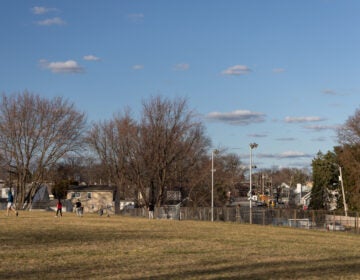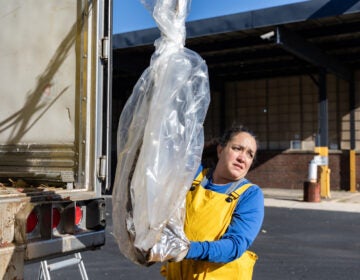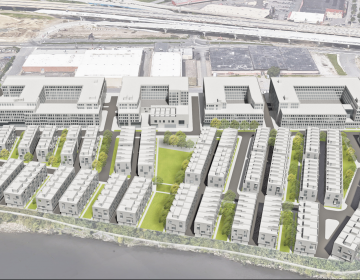Can Graffiti Pier become a tourist attraction and still serve the people who put it on the map?
Graffiti Pier is on track for reinvention into a public park unlike any other in the United States.
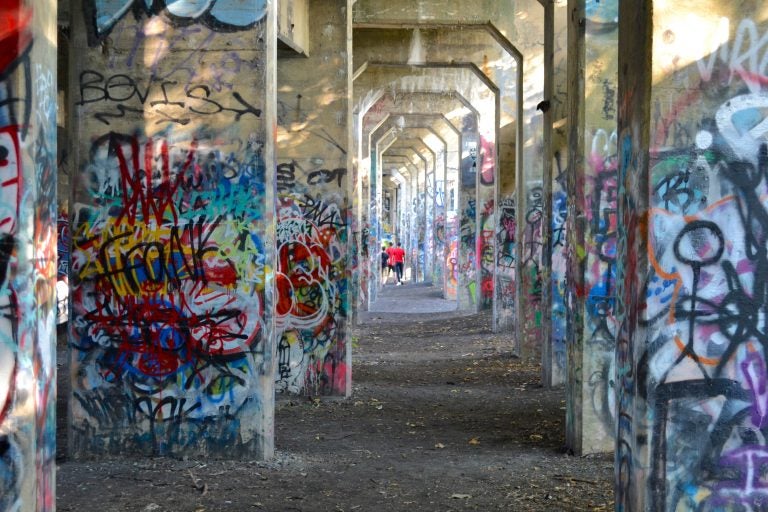
Visitors walk under the arches of Graffiti Pier. (Joel Wolfram for WHYY)
This article originally appeared on PlanPhilly.
—
Jameel Kemp looked doubtful as he approached the forbidding trailhead for Graffiti Pier on a recent July evening. The “no trespassing” signs were insistent, and several layers of barricades stood in the way: concrete jersey barriers, a chain-link fence, and an old swing gate chained shut.
But as soon as he began to consider a way through, another group of visitors walked around the jersey barriers, followed a path that led through tall wildflowers, and slipped behind the fence. Nothing to it.
“I was about to be mad as hell,” said Kemp, 24, of Germantown.
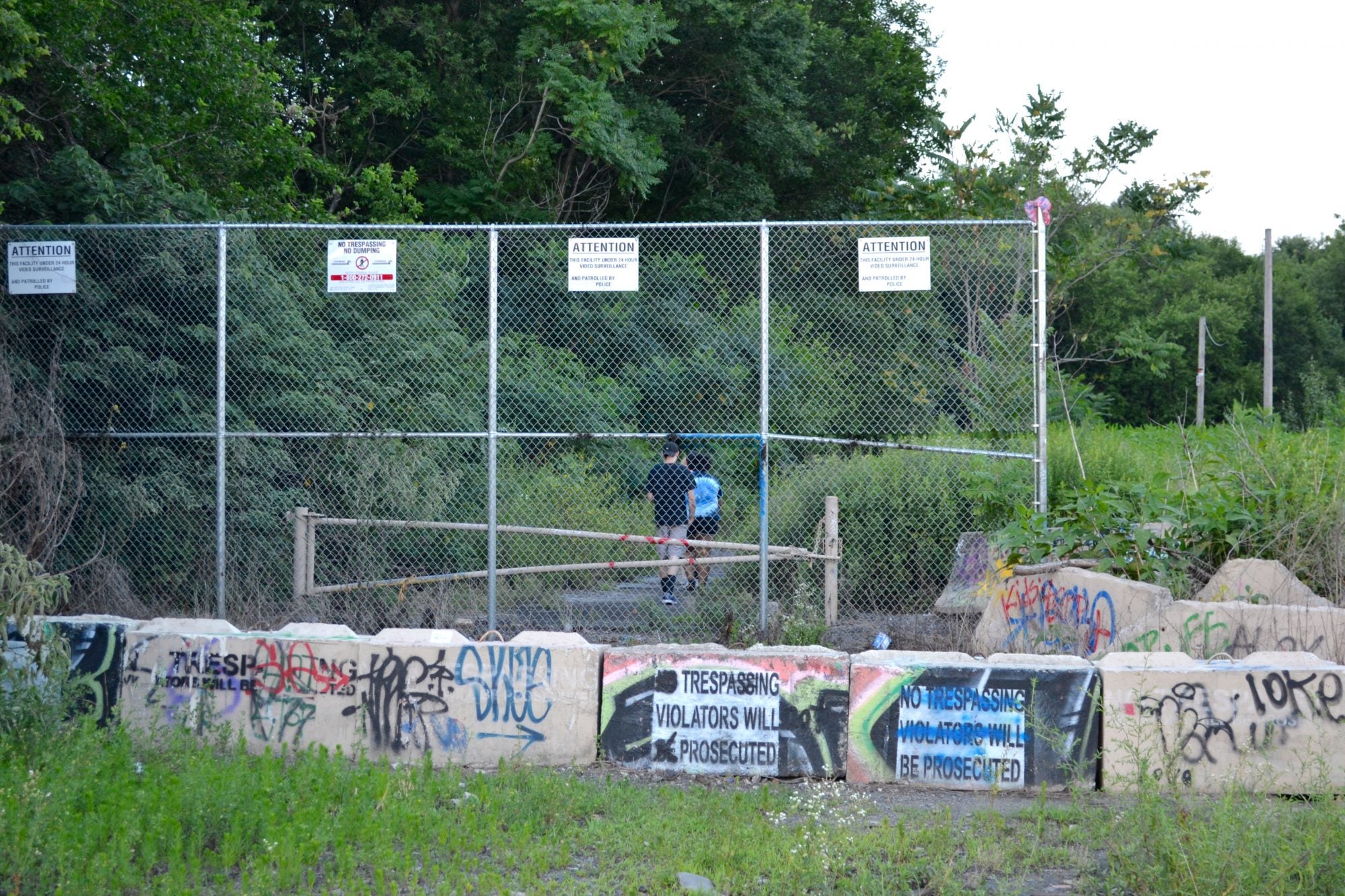
He has been coming to the concrete ruin decorated with the brash lettering and bold colors of graffiti art since he was a kid when his parents first took him.
“My brother started doing art just because my people used to take us back here,” Kemp said.
He was one of dozens who flocked to the Delaware River pier on that golden summer evening, undeterred by the barricades and the risk of criminal trespassing. About a year ago, the Philadelphia Police Department, citing safety concerns, said it would begin cracking down on trespassers and towing vehicles that parked outside the gate. But Graffiti Pier appeared as popular as ever, drawing visitors that day from South Jersey, Ohio, and England. They came to take pictures of the street art covering the old coal-loading dock, to take in the stunning views of the city skyline, to cast fishing lines into the river, or to spray the walls.
They won’t have to trespass for much longer.
Graffiti Pier is on track for reinvention into a public park unlike any other in the United States.
The Delaware River Waterfront Corporation has signed an agreement to buy the property from railroad operator Conrail with plans to fundraise to connect the six-acre parcel to its burgeoning network of public trails and waterfront parks.
Like other recent DRWC projects such as Spruce Street Harbor Park and Cherry Street Pier closer to Center City, the genesis of the park is a desire to connect Philadelphians to the river. As it extends its presence farther north with Graffiti Pier, the organization has stressed that the park will be designed first and foremost for the communities that converge there now: residents hungry for river access, street artists, and others seeking to experience this untamed piece of the waterfront.
That could even mean allowing graffiti writers to continue to use the pier as their canvas, DRWC officials said.
It’s a unique vision for a park that could marry several urban trends into a single highly Instagrammable six-acre attraction. Conrail and DRWC are following an increasingly familiar playbook with their plans. New York, Atlanta, Chicago, Washington D.C.and New Orleans just recently spent millions of dollars to transform abandoned infrastructure into hip new parks. Philly last year opened the Rail Park on two once-overgrown train lines.
But Graffiti Pier’s rebirth comes at a time when the planners behind these new destinations are grappling with the power they wield over changing urban communities. While well-maintained public spaces can provide needed green space and add to the quality of life in a community, these amenities also may inadvertently end up changing the fabric of the surrounding neighborhood, adding to tensions. They can also contribute to rising property values, and stoke fears of displacement among longtime residents.
In Graffiti Pier’s case, the project seems likely to add fuel to the area’s hot real estate market. Jon Broder, Conrail’s vice president for corporate development, said he expected the new park to “spur and catalyze” the redevelopment of the company’s adjacent vacant property.
“In some respects, this property is almost the riverfront gateway into the beginning of Fishtown,” Broder said.
There is no doubt the location, between booming Fishtown and gentrifying Port Richmond, is prime for development. It’s already becoming more popular with visitors from more distant communities, who discover it through Google searches or the more than 12,000 photos tagged to the location on Instagram. Just a few days before Conrail announced its plan to sell Graffiti Pier, a developer went public with plans for 1,100 new homes on an old industrial lot immediately to the south of the future park.
As they design the space, planners will have to consider how to leave room for artists and local adventurers who now use the space as newcomers and tourists discover it.
And they will have to ensure the park benefits the existing community, even as it fuels redevelopment of the valuable riverfront land around it.
Some see it as a difficult needle to thread.
“This isn’t just for special people,” said Emory Lund, a Philadelphia resident who creates graffiti art at the pier. “It’s gotta be seen by everybody.”
Where visitors could go to see the ‘real Philly’
In a past life, Pier 18 was where the Reading Company’s trains unloaded Pennsylvania anthracite coal into ships bound for ports all over the world. It was part of the vast Port Richmond rail yard, which was taken over by Conrail in 1976 after the coal industry declined and the Reading Company went bankrupt.
“We essentially mothballed the property around 1980,” Broder said.
Conrail still operates an active rail yard that covers another 100 acres to the north.
It wasn’t long before adventurous locals discovered the abandoned pier. Port Richmond resident Nghia Tran, now 43, remembered skipping school to play there in the late ’80s.

“We used to swim over there often, and catch fish, light up a fire, and just put ‘em over the fire,” Tran recalled on a recent visit to Graffiti Pier to fish with his three young daughters.
From the trail that leads to the pier, colorful concrete arches stretch into the river as far as the eye can see. A footpath runs along the trees and brush growing alongside the arches, leading to a breathtaking lookout at the end of the pier that thousands have trekked to see.
“It’s one of our most Instagrammed sites in Philadelphia,” said Jeff Guaracino, CEO of Visit Philadelphia.
Kam and Sunny Mistry, siblings from South Jersey, went for the first time with a teenage cousin who was visiting from Leicester, England.
“I thought it would be pretty cool to check out, but the initial thought is like, ‘Is it safe to go?’” said Sunny Mistry, who carried a camera around her neck.
Both siblings welcomed the idea of turning the pier into an official public park, though they worried about preserving the graffiti culture that made it famous.
“I just hope it doesn’t stifle the creativity, like kind of push people out to find other places to go just because there will be too many people here,” Kam Mistry said.
It remains to be seen just how many more people will be drawn to the pier once it becomes an official park. But the head of Philadelphia’s official tourism marketing agency said a revamped Graffiti Pier had the potential to draw more visitors, and that he would promote the new park to tourists.
“Certain types of visitors do love to go and discover the real Philly,” Guaracino said. “They want to go out and explore the neighborhoods.”
When the deal with Conrail goes through, DRWC will have the space for an attraction slightly smaller than Fishtown’s Penn Treaty Park, about a mile to the south. The public park will encompass land connecting Graffiti Pier to an access road and another smaller pier to the south. The DRWC’s Joe Forkin said it would be big enough to ensure existing users and local residents have ample space to enjoy.
“This isn’t a pocket park that would be overrun by international tourists wanting to experience art,” said Forkin, the president of the DRWC, which manages development of the central Delaware waterfront in Philadelphia “This is six acres of land, and I think enough to accommodate and provide that type of equity to different users within the space.”
The DRWC envisions the Pier 18 park as part of a plan for public space along every half-mile of the waterfront it manages between Allegheny and Oregon avenues in South Philly.
Forkin said that community engagement during the planning phases would help ensure Graffiti Pier appeals to everyday park-goers, and finds the right “balance” of visitors. The future park could provide the riverfront green space nearby residents want. Until now, industrial uses have monopolized the banks of the Delaware adjacent to the Olde Richmond neighborhood.
“It’s really great to be opening up the waterfront to our community,” said Rosemary Thomas, president of the Olde Richmond Civic Association. “That’s not something that anyone here has had access to ever, really.”
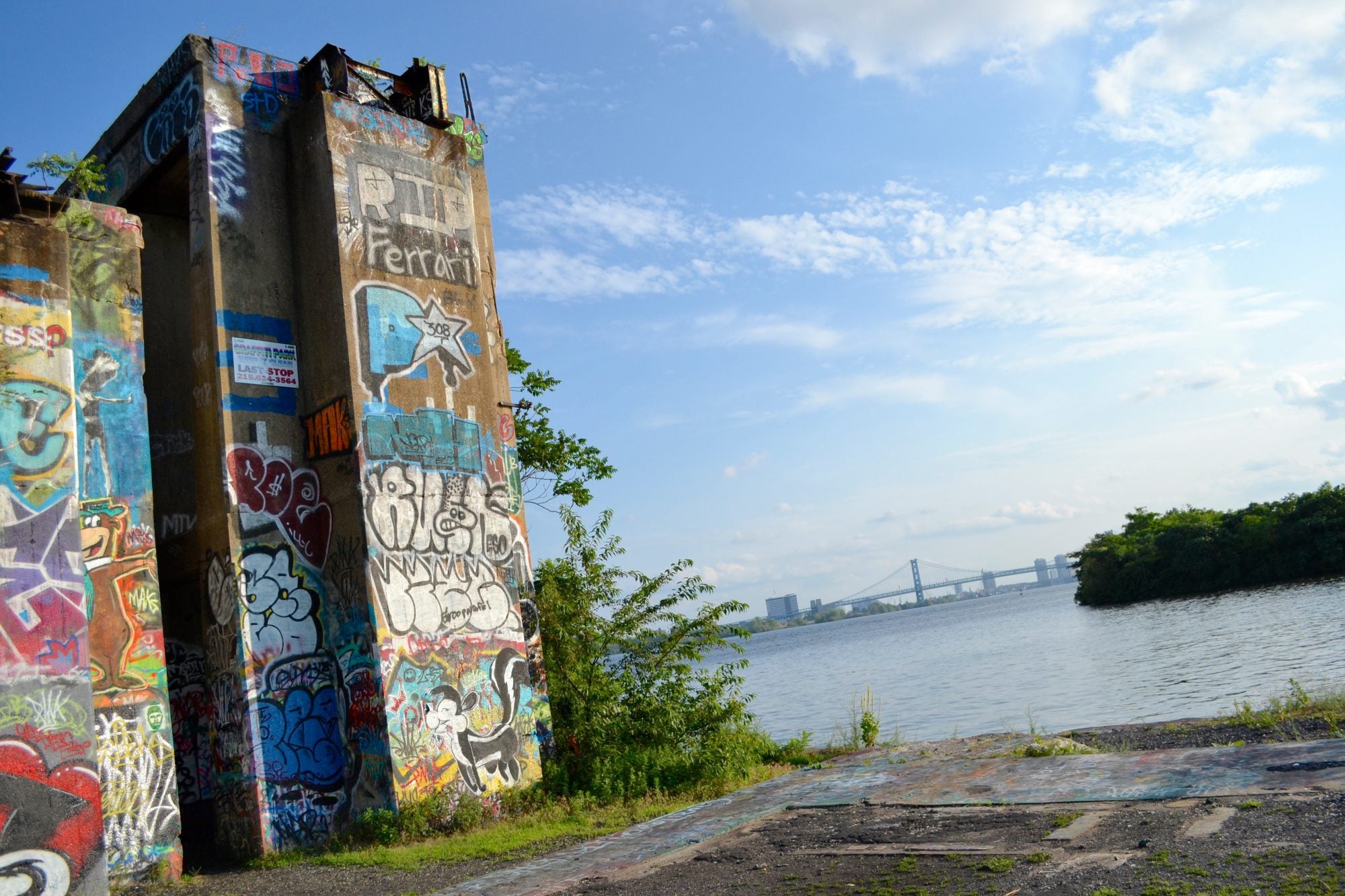
Preserving a haven for graffiti artists
As the pier becomes a sanctioned public space, what will become of the graffiti art culture that has thrived in the feral, abandoned space? That question was on the minds of graffiti artists spraying the walls of Pier 18 on the recent July evening.
Emory Lund and three other artists were painting in an alcove that might once have been an interior room of the structure. They were putting the finishing touches on freshly-sprayed tags: “GEARS,” one said, in boisterous purple bubble letters. Graffiti Pier offered them a relatively safe place to spray and meet other artists, without much risk of getting in trouble, the artists said.
“You can come back here, you can practice. Get better at it,” Lund said over a rattle of shaken paint cans. “Cops aren’t going to be right on you. They don’t usually mess with us.”
There was no other place in the city like it, the artists said.
“If they tear this place down, I can almost guarantee you all the graffiti that’s in here is going to go right back out on the street,” said Tim Lee, 25, of Southwest Philadelphia.

Lee and Lund spitballed ideas for how to preserve this living, but decaying, canvas even after it gets incorporated into the new park. Lee hoped engineers could preserve the structure, perhaps patching it up where needed or adding railings to make it safer for park-goers. Lund suggested putting up glass walls around sections where artists were actively spraying.
The future of graffiti art at the pier will be one of the “primary questions” facing planners, said Lizzie Woods, vice president of planning and capital programs at the DRWC. An engineering study will shed light on the pier’s structural integrity, and how much of that concrete canvas can be preserved. Planners will even explore the possibility of allowing street art to continue through its engagement with local residents and the street artist community, Woods said.
“We’re not trying to presuppose any configuration for that,” Woods said. “We are open to what the community wants to see there.”
Still, some proponents of graffiti art fear that new alterations or restrictions could detract from the pier’s authenticity as a venue for unregulated expression.
“If they get rid of the structure, or if they try to limit artists and writers from creating on that structure in any way, then they will be eliminating the very thing that’s made that space so beloved in the first place,” said Conrad Benner, a photographer and curator who founded the popular street art blog, StreetsDept.com.
Thomas, of the Olde Richmond Civic Association, said Graffiti Pier could best serve the local neighborhood by accommodating a mix of younger residents more likely to appreciate the cultural value of street art and an older generation of folks who may be less impressed.
“A park or public space that’s accessible to everyone I think is really critical, regardless of who they are, their background, income, age,” Thomas said.
Lee and Lund said they wanted to participate in community engagement meetings, and would approach them with an open mind.
“Whatever plans they want to talk about doing to the place, as long as they’re not literally trying to tear it down, I’m cool with it,” Lee said.
Anticipating future waterfront development
The six acres of parkland in question represents a small fraction of the vacant land Conrail owns south of the Port Richmond rail yard. The future park’s impact on those 80-odd acres of waterfront land, and on the changing neighborhoods around it, could have implications for its community-focused goals. How will future development around the pier affect the character of the space, and who stands to benefit from it?
Nowadays, planners of urban park projects are even asking themselves these questions that go beyond the design of the actual space.
The 11th Street Bridge Park in Washington, D.C., for example, is making equitable development and inclusion central to the planning process. When completed, the decommissioned bridge over the Anacostia River will become a green oasis connecting the affluent Capitol Hill neighborhood with the lower-income areas across the river.
Aware that the new park is likely to drive up property values and rents, the nonprofit building the park has tried to ensure sure that all of Anacostia benefits from the park. Working with the community, the park organizers created a plan that includes job training, the creation of a community land trust, and other investments to create affordable housing in the neighborhood.
These are things that, to some, “at first pass may seem like mission creep,” said Danya Sherman, a community development consultant and former community engagement director at New York’s High Line rail park. “But if you think about the intention behind public infrastructure being to benefit all, in the context of extreme economic inequality, maybe we need to consider programs like affordable housing, and grassroots organizing, and business support.”
Sherman wasn’t commenting specifically on Graffiti Pier, and the circumstances surrounding the D.C. park have their differences. For instance, rather than being placed in the middle of an existing neighborhood, the pier is surrounded by vacant property.
The developers of the new pier park said while there aren’t plans yet to incorporate measures similar to the 11th Street Bridge project, they were keeping an open mind to community concerns along those lines.
“Anyone who works in public space in the country right now is thinking about those issues,” said Woods from DRWC. “What we’re interested in is being responsive to the needs and the desires of the communities that we’re talking to, and to develop a plan for the park that responds to those needs. So, I think that we’ll know a lot more about how we can address those potential issues once we start actually talking to people.”
All the players involved expect more redevelopment of the waterfront to follow Graffiti Pier’s transformation.
That could be a good thing, as long as it doesn’t create “private communities on the waterfront where the rest of the community feels shut out,” said Thomas, from the local neighborhood association.
She and some of her neighbors had concerns about the residential development in the work south of the pier, Thomas said. They feared the development and open spaces planned there will feel exclusive.
Woods said the development potential around the pier was one reason it was important for the organization to engage with the community early in the planning process. The more planners can get neighbors and current users of the waterfront to become stewards of the new park, the more they will “continue to feel that the park is an asset for them, even if the neighborhood changes in some way, that the park is always going to be open and accessible to all,” Woods said.
Beyond just convening community design meetings, Sherman said it was also important that community members have real power in the decision-making process.
“No number of charrettes can ensure that the process will make it meaningful and democratic,” she said.
The Olde Richmond Civic Association’s Thomas said that to combat the atmosphere of exclusivity she fears, planners should think about how to create a “gateway” under I-95 to visually draw visitors to the new park entrance.
The raised highway, which stands between the neighborhood and the river, acted as a barrier, which could inhibit residents’ access to Graffiti Pier and the rest of the waterfront.
The shape the new Graffiti Pier park ultimately takes could in turn help determine appropriate uses for the rest of the old Reading Company’s coal yards, Conrail’s Broder said.
“We really are at the very beginning of trying to understand what makes the most sense for that area for the community and for Conrail,” he said.
As of now, the only other carve-out for public space Conrail is contemplating is an extension of the DRWC’s Delaware River Trail along the waterfront, Broder said.
Community engagement will kick off in the fall, the DRWC said. It hopes to complete its initial concept for the park and close the land sale with Conrail by next summer. If final designs and fundraising for construction go smoothly, Graffiti Pier could be off-limits no more in three to four years.
WHYY is your source for fact-based, in-depth journalism and information. As a nonprofit organization, we rely on financial support from readers like you. Please give today.




